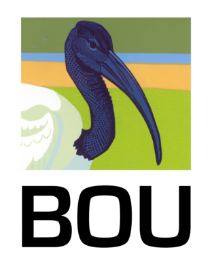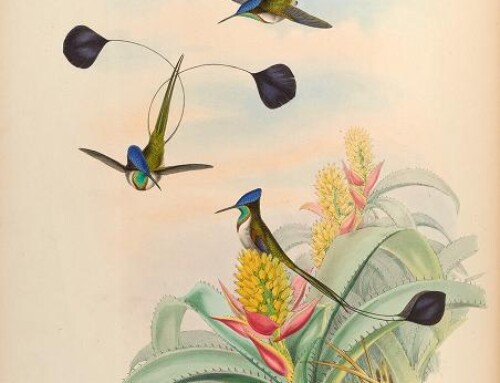As much as I would love to write about my favourite rock album covers, this is an ornithology blog. So, my topic today is the images of birds painted on or etched into rock surfaces by humans who lived in Africa, Eurasia, and Australasia as long as 50,000 years ago. The period from 50,000 to 12,000 years ago is now called the Upper Paleolithic, or Old Stone Age, long before the Sumerians, Egyptians, Chinese, and MesoAmericans independently ‘invented’ what we now characterize as ‘writing’ to convey information that could be understood by contemporaries and their descendants.

Anthropologists recognize four kinds of rock art but today I am focussing on those images either painted on or scratched into usually vertical rock surfaces. Almost all the paintings that survived to the present day are in caves or rock shelters where they were protected from the elements, so we usually call them cave paintings. The etchings on rock (called ‘petroglyphs’) are more durable, and are most often found on exposed rock surfaces and not in dark caves. Any paint that had been applied by a paleolithic artist on exposed rock would have weathered away long ago. Some of those petroglyphs have been painted, usually red, long after the etchings were made, by archaeologists and curators to make them more visible for both study and appreciation.
Among the hundreds of cave paintings of animals that have been discovered since 1879—when Marcelino Sanz de Sautuola found the fabulous artwork in the Cave of Altamira in Spain—there are precious few birds among the myriad aurochs, horses, bison, deer, and big cats. In European caves, for example, the only birds painted on cave walls are a few Great Auks, owls, and corvids (raven or crow), numbering less than ten in total. In 2012, I was able to explore a cave—Le Portel—on private property in Ariege, France—where there was the unmistakable image of an owl among the dozens of animal and humanoid images on the cave’s walls. The hundreds of famous cave paintings at the Grotte de Niaux, France, only 40 km—as the paleolithic crow would have flown—from Le Portel included no birds at all.

Almost all the cave paintings in Europe are deep within immense cave networks where there is no ambient light and the access to walls with paintings often involves squeezing through very narrow rock crevices deep within the caves. At the La Portel, cave we had to shimmy down a tight vertical shaft beside a large boulder just to get into the cave, then walked, crawled, and slithered for hours into the various branches of the cave to visit all the paintings. I am somewhat claustrophobic and so was constantly suppressing panic attacks though the entire experience, as well as at the Grotte de Niaux, was fantastic.
Why did those paleolithic peoples, who had only fire on sticks to light their way, go to such lengths to paint those images? It was a daunting enough task in hiking boots, headlamps, and iPhones to mark our trails in and out of those caves in Ariege. The general consensus is that these images probably had some magico-religious significance. Certainly when our guide at Grotte de Niaux performed a beautiful Gregorian chant in the dim light from our lamps in the largest cave, the hair stood up on the back of my neck. The experience was not unlike being in one of the great cathedrals at Notre Dame or Carcassonne when the organist is playing. Whether or not you are a believer, those are magico-religious experiences.

It certainly seems reasonable to me that images of owls and corvids would be associated with magic and religion, but what about the Great Auk? Even today, owls and corvids are birds of mystery and imagination. Maybe the Great Auk, being large and the only flightless bird in Europe, was also shrouded in mystery. When Jacques Cartier visited Funk Island off the northeast coast of Newfoundland to harvest barrels of Great Auks, many of his crew thought that the birds were witches. And when five men from St Kilda captured a sleeping Great Auk around 1840, they bound it and kept it in a small hut where it bellowed whenever anyone approached. When a fierce storm blew in, the men thought that trhe storm was caused by the bird which they then stoned to death, assuming it was a witch.
Birds are much more common in petroglyphs and paintings found on rock walls that are visible with natural light and do not involve crawling deep into subterranean caves. The fabulous Cueva del Tajo de las Figuras site, halfway between Cadíz and Gibraltar in southern Spain, is a case in point. Although it is called a cave, it is really just a shelter scooped out of the sandstone, with its walls readily visible during the daylight hours. There, more than 500 images were painted in white, red, and yellow, depicting at least 200 birds, as well as deer, other quadrupeds, and stick figures of humans. Some of the birds are identifiable as bustards, geese, ducks, spoonbills, ibises, coots, gallinules, herons, egrets, cranes, flamingos, avocets, stilts, harriers, and vultures (Lazarich et al. 2019). Some of the humans are clearly holding spears for hunting, and all the birds and mammals are relatively large species that would have been worth killing for food. There are no obvious passerines, small rodents, or herptiles. This suggest to me that this rock art may have served to inform others of a local bounty available for the hunt.

The petroglyphs at Alta in northern Norway—etched between 5000 and 2000 years ago—similarly display hunters and about 25 birds among more than 1500 large mammals. There, many of the birds can be identified to type or even species as they look like cormorants, geese, and even a few Great Auks. One of the birds that looks most like a Great Auk is being held by the neck by a stick-figure human, suggesting that that was how this flightless, and now extinct, species was captured on land. Again, all the birds are large ones that would have been good for the table.

My guess is that the petroglyphs and paintings on exposed rock were not there for magico-religious purposes but rather as a pre-writing and pre-hieroglyphic form of communication that would aid other hunters to be aware of the local bounty. Just as we do today in many other contexts, they could also have been just a way that hunters celebrated their success by creating a permanent record for all to see.
Further Reading
Achrati, A. (2023) Birds, dream-flying, avian metaphors and rock art. Rock Art Research 40: 70–88. VIEW
Birkhead, T.R. and Montgomerie, R.(2025) A Neolithic rock engraving apparently showing a Great Auk being captured. Ibis (online)VIEW
Lazarich, M., Antonio, R-G. and González-Pérez, J. (2019) Prehistoric bird watching in Southern Iberia? The rock art of Tajo de las Figuras reconsidered. Environmental Archaeology 24: 1-13.VIEW
Image credits
Album covers and the mammals and owl at La Portel by the author
Cava del Tajo de las Figuras illustration from Lazarich et al. (2019)
Alta birds from Birkhead and Montgomerie (2025)
Grotte de Niaux cave paintings from Agence de Développement Touristique d’Ariège Pyrénées, All rights reserved. Usage permitted as described on their website at https://www.ariegepyrenees.com/mentions-legales/





